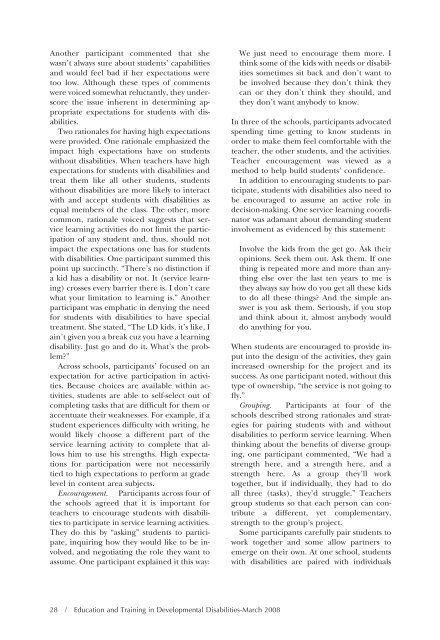Download the Journal (PDF) - Division on Autism and ...
Download the Journal (PDF) - Division on Autism and ...
Download the Journal (PDF) - Division on Autism and ...
You also want an ePaper? Increase the reach of your titles
YUMPU automatically turns print PDFs into web optimized ePapers that Google loves.
Ano<str<strong>on</strong>g>the</str<strong>on</strong>g>r participant commented that she<br />
wasn’t always sure about students’ capabilities<br />
<strong>and</strong> would feel bad if her expectati<strong>on</strong>s were<br />
too low. Although <str<strong>on</strong>g>the</str<strong>on</strong>g>se types of comments<br />
were voiced somewhat reluctantly, <str<strong>on</strong>g>the</str<strong>on</strong>g>y underscore<br />
<str<strong>on</strong>g>the</str<strong>on</strong>g> issue inherent in determining appropriate<br />
expectati<strong>on</strong>s for students with disabilities.<br />
Two rati<strong>on</strong>ales for having high expectati<strong>on</strong>s<br />
were provided. One rati<strong>on</strong>ale emphasized <str<strong>on</strong>g>the</str<strong>on</strong>g><br />
impact high expectati<strong>on</strong>s have <strong>on</strong> students<br />
without disabilities. When teachers have high<br />
expectati<strong>on</strong>s for students with disabilities <strong>and</strong><br />
treat <str<strong>on</strong>g>the</str<strong>on</strong>g>m like all o<str<strong>on</strong>g>the</str<strong>on</strong>g>r students, students<br />
without disabilities are more likely to interact<br />
with <strong>and</strong> accept students with disabilities as<br />
equal members of <str<strong>on</strong>g>the</str<strong>on</strong>g> class. The o<str<strong>on</strong>g>the</str<strong>on</strong>g>r, more<br />
comm<strong>on</strong>, rati<strong>on</strong>ale voiced suggests that service<br />
learning activities do not limit <str<strong>on</strong>g>the</str<strong>on</strong>g> participati<strong>on</strong><br />
of any student <strong>and</strong>, thus, should not<br />
impact <str<strong>on</strong>g>the</str<strong>on</strong>g> expectati<strong>on</strong>s <strong>on</strong>e has for students<br />
with disabilities. One participant summed this<br />
point up succinctly. “There’s no distincti<strong>on</strong> if<br />
a kid has a disability or not. It (service learning)<br />
crosses every barrier <str<strong>on</strong>g>the</str<strong>on</strong>g>re is. I d<strong>on</strong>’t care<br />
what your limitati<strong>on</strong> to learning is.” Ano<str<strong>on</strong>g>the</str<strong>on</strong>g>r<br />
participant was emphatic in denying <str<strong>on</strong>g>the</str<strong>on</strong>g> need<br />
for students with disabilities to have special<br />
treatment. She stated, “The LD kids, it’s like, I<br />
ain’t given you a break cuz you have a learning<br />
disability. Just go <strong>and</strong> do it. What’s <str<strong>on</strong>g>the</str<strong>on</strong>g> problem?”<br />
Across schools, participants’ focused <strong>on</strong> an<br />
expectati<strong>on</strong> for active participati<strong>on</strong> in activities.<br />
Because choices are available within activities,<br />
students are able to self-select out of<br />
completing tasks that are difficult for <str<strong>on</strong>g>the</str<strong>on</strong>g>m or<br />
accentuate <str<strong>on</strong>g>the</str<strong>on</strong>g>ir weaknesses. For example, if a<br />
student experiences difficulty with writing, he<br />
would likely choose a different part of <str<strong>on</strong>g>the</str<strong>on</strong>g><br />
service learning activity to complete that allows<br />
him to use his strengths. High expectati<strong>on</strong>s<br />
for participati<strong>on</strong> were not necessarily<br />
tied to high expectati<strong>on</strong>s to perform at grade<br />
level in c<strong>on</strong>tent area subjects.<br />
Encouragement. Participants across four of<br />
<str<strong>on</strong>g>the</str<strong>on</strong>g> schools agreed that it is important for<br />
teachers to encourage students with disabilities<br />
to participate in service learning activities.<br />
They do this by “asking” students to participate,<br />
inquiring how <str<strong>on</strong>g>the</str<strong>on</strong>g>y would like to be involved,<br />
<strong>and</strong> negotiating <str<strong>on</strong>g>the</str<strong>on</strong>g> role <str<strong>on</strong>g>the</str<strong>on</strong>g>y want to<br />
assume. One participant explained it this way:<br />
28 / Educati<strong>on</strong> <strong>and</strong> Training in Developmental Disabilities-March 2008<br />
We just need to encourage <str<strong>on</strong>g>the</str<strong>on</strong>g>m more. I<br />
think some of <str<strong>on</strong>g>the</str<strong>on</strong>g> kids with needs or disabilities<br />
sometimes sit back <strong>and</strong> d<strong>on</strong>’t want to<br />
be involved because <str<strong>on</strong>g>the</str<strong>on</strong>g>y d<strong>on</strong>’t think <str<strong>on</strong>g>the</str<strong>on</strong>g>y<br />
can or <str<strong>on</strong>g>the</str<strong>on</strong>g>y d<strong>on</strong>’t think <str<strong>on</strong>g>the</str<strong>on</strong>g>y should, <strong>and</strong><br />
<str<strong>on</strong>g>the</str<strong>on</strong>g>y d<strong>on</strong>’t want anybody to know.<br />
In three of <str<strong>on</strong>g>the</str<strong>on</strong>g> schools, participants advocated<br />
spending time getting to know students in<br />
order to make <str<strong>on</strong>g>the</str<strong>on</strong>g>m feel comfortable with <str<strong>on</strong>g>the</str<strong>on</strong>g><br />
teacher, <str<strong>on</strong>g>the</str<strong>on</strong>g> o<str<strong>on</strong>g>the</str<strong>on</strong>g>r students, <strong>and</strong> <str<strong>on</strong>g>the</str<strong>on</strong>g> activities.<br />
Teacher encouragement was viewed as a<br />
method to help build students’ c<strong>on</strong>fidence.<br />
In additi<strong>on</strong> to encouraging students to participate,<br />
students with disabilities also need to<br />
be encouraged to assume an active role in<br />
decisi<strong>on</strong>-making. One service learning coordinator<br />
was adamant about dem<strong>and</strong>ing student<br />
involvement as evidenced by this statement:<br />
Involve <str<strong>on</strong>g>the</str<strong>on</strong>g> kids from <str<strong>on</strong>g>the</str<strong>on</strong>g> get go. Ask <str<strong>on</strong>g>the</str<strong>on</strong>g>ir<br />
opini<strong>on</strong>s. Seek <str<strong>on</strong>g>the</str<strong>on</strong>g>m out. Ask <str<strong>on</strong>g>the</str<strong>on</strong>g>m. If <strong>on</strong>e<br />
thing is repeated more <strong>and</strong> more than anything<br />
else over <str<strong>on</strong>g>the</str<strong>on</strong>g> last ten years to me is<br />
<str<strong>on</strong>g>the</str<strong>on</strong>g>y always say how do you get all <str<strong>on</strong>g>the</str<strong>on</strong>g>se kids<br />
to do all <str<strong>on</strong>g>the</str<strong>on</strong>g>se things? And <str<strong>on</strong>g>the</str<strong>on</strong>g> simple answer<br />
is you ask <str<strong>on</strong>g>the</str<strong>on</strong>g>m. Seriously, if you stop<br />
<strong>and</strong> think about it, almost anybody would<br />
do anything for you.<br />
When students are encouraged to provide input<br />
into <str<strong>on</strong>g>the</str<strong>on</strong>g> design of <str<strong>on</strong>g>the</str<strong>on</strong>g> activities, <str<strong>on</strong>g>the</str<strong>on</strong>g>y gain<br />
increased ownership for <str<strong>on</strong>g>the</str<strong>on</strong>g> project <strong>and</strong> its<br />
success. As <strong>on</strong>e participant noted, without this<br />
type of ownership, “<str<strong>on</strong>g>the</str<strong>on</strong>g> service is not going to<br />
fly.”<br />
Grouping. Participants at four of <str<strong>on</strong>g>the</str<strong>on</strong>g><br />
schools described str<strong>on</strong>g rati<strong>on</strong>ales <strong>and</strong> strategies<br />
for pairing students with <strong>and</strong> without<br />
disabilities to perform service learning. When<br />
thinking about <str<strong>on</strong>g>the</str<strong>on</strong>g> benefits of diverse grouping,<br />
<strong>on</strong>e participant commented, “We had a<br />
strength here, <strong>and</strong> a strength here, <strong>and</strong> a<br />
strength here. As a group <str<strong>on</strong>g>the</str<strong>on</strong>g>y’ll work<br />
toge<str<strong>on</strong>g>the</str<strong>on</strong>g>r, but if individually, <str<strong>on</strong>g>the</str<strong>on</strong>g>y had to do<br />
all three (tasks), <str<strong>on</strong>g>the</str<strong>on</strong>g>y’d struggle.” Teachers<br />
group students so that each pers<strong>on</strong> can c<strong>on</strong>tribute<br />
a different, yet complementary,<br />
strength to <str<strong>on</strong>g>the</str<strong>on</strong>g> group’s project.<br />
Some participants carefully pair students to<br />
work toge<str<strong>on</strong>g>the</str<strong>on</strong>g>r <strong>and</strong> some allow partners to<br />
emerge <strong>on</strong> <str<strong>on</strong>g>the</str<strong>on</strong>g>ir own. At <strong>on</strong>e school, students<br />
with disabilities are paired with individuals
















